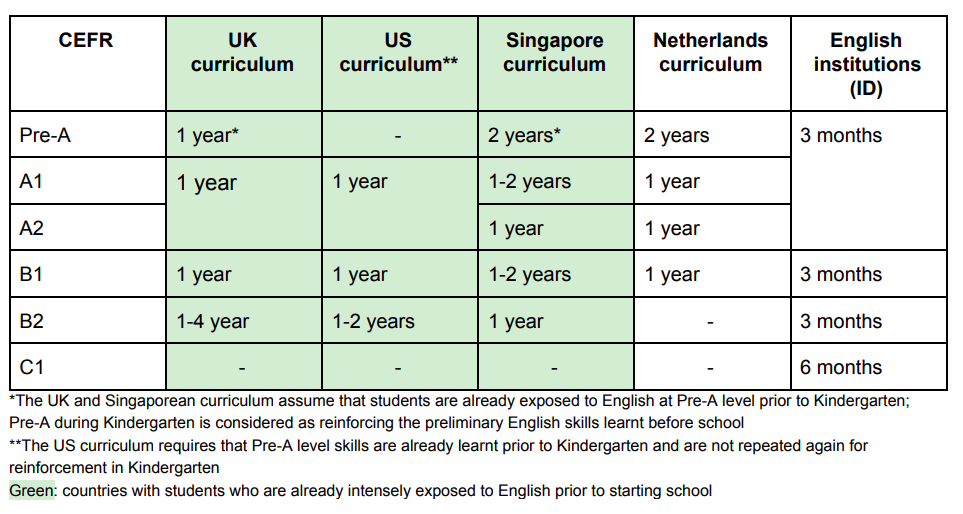After research into English language curriculums around the world, we concluded that in terms of study duration in years, the result is as follows:
 The total number of years needed to learn English is summarized in the table below:
The total number of years needed to learn English is summarized in the table below:
 Learning hours per week in primary schools are fewer than the amount of learning hours in test prep institutions since primary school students must split their time and attention for several other subjects as well. Therefore the conclusion is divided into extensive learning (school curriculum) and intensive learning (test preps).
Comparisons to the UK and US curriculum are not as relevant as comparisons to the Singapore and Netherlands curriculum as the CEFR is designed to grade learners of a second language. The curriculum in the UK and US are designed for native speakers of English with early exposure to the language, therefore their curriculum is more focused on literacy skills than the language itself.
The above conclusion was made with the following underlying assumptions:
Learning hours per week in primary schools are fewer than the amount of learning hours in test prep institutions since primary school students must split their time and attention for several other subjects as well. Therefore the conclusion is divided into extensive learning (school curriculum) and intensive learning (test preps).
Comparisons to the UK and US curriculum are not as relevant as comparisons to the Singapore and Netherlands curriculum as the CEFR is designed to grade learners of a second language. The curriculum in the UK and US are designed for native speakers of English with early exposure to the language, therefore their curriculum is more focused on literacy skills than the language itself.
The above conclusion was made with the following underlying assumptions:
 The total number of years needed to learn English is summarized in the table below:
The total number of years needed to learn English is summarized in the table below:
 Learning hours per week in primary schools are fewer than the amount of learning hours in test prep institutions since primary school students must split their time and attention for several other subjects as well. Therefore the conclusion is divided into extensive learning (school curriculum) and intensive learning (test preps).
Comparisons to the UK and US curriculum are not as relevant as comparisons to the Singapore and Netherlands curriculum as the CEFR is designed to grade learners of a second language. The curriculum in the UK and US are designed for native speakers of English with early exposure to the language, therefore their curriculum is more focused on literacy skills than the language itself.
The above conclusion was made with the following underlying assumptions:
Learning hours per week in primary schools are fewer than the amount of learning hours in test prep institutions since primary school students must split their time and attention for several other subjects as well. Therefore the conclusion is divided into extensive learning (school curriculum) and intensive learning (test preps).
Comparisons to the UK and US curriculum are not as relevant as comparisons to the Singapore and Netherlands curriculum as the CEFR is designed to grade learners of a second language. The curriculum in the UK and US are designed for native speakers of English with early exposure to the language, therefore their curriculum is more focused on literacy skills than the language itself.
The above conclusion was made with the following underlying assumptions:
- Learning capabilities and learning rates are the same across all ages and cultures
- Learning capabilities of native English speakers and non-native English speakers are the same
- Teaching methods and materials are the same across all curriculums
- Teacher quality is the same across all observed countries

